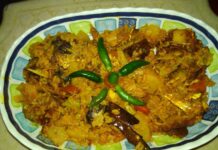Kimbap-bite sized Korean delicacy
Thanks to the popularity of K Pop and Korean drama, Korean food has become very popular globally as also India. The Japanese colonization of Korea led to the development of a food item that is inspired by the Japanese delight Sushi. Rolled in edible seaweed cooked rice mixed with other ingredients, this dish was originally called gimbap. The name has then been romanized on to Kimbap by which it has today become very famous. Bite-sized, the food easily fits into takeaway boxes and picnic boxes. Our food journey is today to the orient with Kimbap, where we will make an easy variant with chicken
The name Gimbap probably originates from the main ingredients of the food. The edible sea wood that is used to roll is called Gim, while Bap is the cooked rice that is essential to the food. In fact, the term gimbap was not part of the Korean vocabulary till modern times when it was incorporated into the language. A loanword that was in vogue when this was first used around 1935 was Norimaki, and the two words were used interchangeably till the word Gimbap was finally accepted universally. In terms of origin, some believe the Makizushi variant of sushi was introduced to Korea during the Japanese occupation of Korea. Typically sushi is raw fish and rice seasoned with rice vinegar and wrapped in nori or seaweed. The essential difference between kimbap and sushi lies in the rice. For sushi, the rice is flavored with rice vinegar, while the kimbap rice is flavored with sweetener and sesame oil. The other major difference is in the filling, where sushi is primarily raw fish, the kimbap has an assortment of cooked or preserved food items like canned tuna, kimchi, cheese, etc. Gyeongsang and Jeolla provinces have books from the 15th century where bap that is cooked rice is rolled in gim or edible seaweed along with side dishes or banchan. This was then called boksam in the prevalent hanja script with pronunciation being bakjeom. Popular health choices make available options that are vegetarian and even vegan, but typically meat in any form- fur, feather, or fin and shell is typically used as the filling for the kimbap. Typically kimbap is made by rolling cooked rice seasoned with sesame oil along with the other ingredients in a gim sheet toasted over low heat. The roll is usually made with a diameter of 3-4 cms and then cut into bite-sized pieces. Culturally Koreans believe the selling of uncut gimbap to be a noble form of busking rather than begging or unskilled busking, and many street-side vendors do the same as opposed to begging. The whole log also signifies longevity and extends the shelf life as opposed to the cut variants. Typically these are sold out of various franchisee restaurants or restaurants or even as part of picnic hampers as part of packed meals called dosirak. This can also be had as a light lunch popular as a takeaway when combined with kimchi.
As always the cooking journey will start from our common starting point a raid of my mother’s pantry. To cook a serving portion for 3-4 people(about 6 logs and 36 kimbap pieces) we will need
- Cucumber 1 large (350 gms)
- Eggs 3
- Ham strips 6 that have been cut about ¼ inch thick
- Carrot 1 medium (250 gms) cut in long strips (juliennes)
- Korean fish (Oden) cakes 3 sheets cut into strips again ¼ inches thick
- Oligosaccharide syrup (oligodang) 2 tsp
- Soy sauce 1 tsp
- Pickled radish (damunji) 1 large (250 gms)
- Artificial crab meat (surimi)3 long strips cut halfways
- Cooked short grain rice 3 cups
- Sesame seeds 1 and ½ tsp roasted and crushed
- Sesame oil 25 ml for kimbap and more for brushing
- Gim (nori) sheets 6 square sheets
- Gimbal mat
- Sea salt to taste
Now that our pantry raid is over let us get going in making our kimbap today. The rice (as mentioned ) is first cooked and set aside as a first step. The vegetables are cut as indicated including the cucumber, the damunji, and carrot. The surimi, oden cakes, and ham are also cut into strips. The cucumber is seasoned with salt and set aside. All strips we make are 6 in number as we will make 6 logs.
In a pan cooking oil is heated to medium heat and the eggs are beaten and fried in two batches into two omelet-like shapes and placed on the working area. This is now again cut into strips and set aside. In the same pan now the cucumber juliennes are added to cooking oil that’s on medium-high heat. They are cooked till the cucumber softens and then removed from the oil and set aside. The ham strips are now similarly cooked and set aside. The carrot juliennes are next cooked to a crisp tenderness with a pinch of salt to taste added and set aside. The heat is now lowered and the soy sauce and oigodang syrup are added into the pan, into which the oden cake strips are added and tossed in. Continue cooking till the fish cakes soften and then set aside. Cooking of each element should take about 1 to 2 minutes each. With exception of the rice, all other elements are allowed to cool and set aside.
In a large mixing bowl, the cooked rice is mixed with sesame oil and sesame seeds previously measured out. 6 even portions are now made out of this. Now a gimbal mat or a sushi rolling mat is set and spread on the working table. Alternatively, if the mat is unavailable a shrink (cling film) plastic is spread out. On that, a gim sheet is spread out. Placing a portion of the rice in the center of the sheet, the bap is spread out towards the edges, leaving 1 or 2 inches of the sheet from the top edge free. Now the fillings are arranged in the center of this rice, say one cucumber an egg strip, a ham strip, 1/6th portion of the cooked carrot juliennes, the damunji, oden cake strip, and surimi stick. The mat is now rolled, such that the seaweed sheet and rice curls around the centrally placed ingredients. Rolling is done up and away from us rather than the other way round. Fingers of both hands are used to ensure that the filling stays in place between the rice while using the thumbs to roll. The roll is secured with the excess flap of the gim sheet left for this. The top and sides of the roll are pressed to compress and seal this. A bit of rice is left free for this at the edge to help in this. A film of water may also be used to get this done. The gim sheets may be toasted lightly over light heat before the rice is placed. This is repeated for all 6 portions till we have 6 logs ready. If we have used cling wrap, after cooking it is removed, if we are using gimbal bamboo mats then it is removed once the logs are properly sealed.
Now we brush a very sharp knife with sesame oil. The same is done with the sides of the kimbap rolls. If we have used a cling wrap we can brush the oil after removing the wrap film. 2 logs are taken and held together and the knife is used to cut slices about ½ inch or about 6 pieces per log. We should have 36 bite-sized pieces at the end of it and ready to be served now. It can be served with or without dipping sauce and with a side of kimchi.
While we get the ingredients we must remember to use a little less water while cooking the rice. That will make it more humid and sticky, thus holding the ingredients together. Also, the stickiness will help roll and seal the roll. The strips that we cut are kept about ¼ inch thick and in length, the size of the rice spread we will make on the gim sheet. So if your portion is large the strips need to be longer, if lesser the strips shorter. Also we need to remember to roll the sheet away from us and use the thumbs for rolling rather than the palm, as that will help maintain evenness. Remember the knife has to be very sharp to cut the log into bite pieces smoothly. But as always my mother’s special bong ingredients work amazingly even making this Korean classic. Love for the ones we cook for and a warm smile while cooking goes a long way in making any cook wonderful and tasty. So I put in my best smile and a huge dollop of love as Imix the bap and roll the gim. Bon Apetit.






